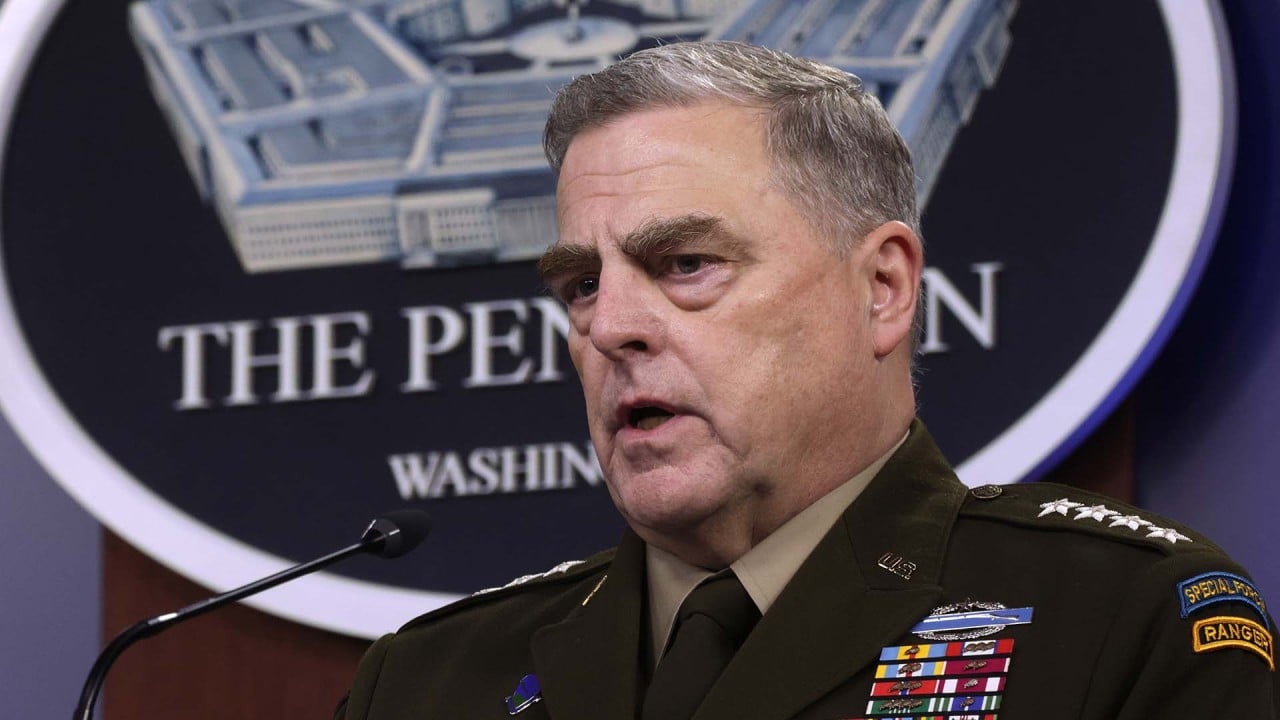
02:06
Chinese hypersonic weapons test ‘has all of our attention’, US General Mark Milley says

China’s recently reported tests of a nuclear-capable hypersonic missile in July and August, though officially denied, are threatening to undermine strategic nuclear stability. They have already added to escalating tensions between the United States and China.
Throughout the summer, satellite images revealed that China was in the process of building as many as 300 new missile silos in its northern deserts. Some of these silos are likely to be used merely as empty decoys. But, if even half of them become sites for nuclear-armed missiles, it would represent a near-tripling of China’s nuclear arsenal.
Following these revelations, the US State Department warned that, “This build-up is concerning. It raises questions about the PRC’s intent … We encourage Beijing to engage with us on practical measures to reduce the risks of destabilising arms races and conflict.”
China’s ambassador for disarmament affairs, Li Song, responded the same day. He described the new Aukus pact between Australia, Britain and the US to help Australia acquire nuclear submarines as a “textbook case” of nuclear proliferation spurring a regional arms race.
To date, China has steadfastly refused to engage in talks with the US on strategic arms control – whether bilaterally or trilaterally with Russia – until the US makes substantial reductions in its own arsenal of active warheads. Yet by pursuing its own rapid expansion, China has begun to undermine this argument, making the need for talks increasingly urgent.
In September, former Chinese ambassador for disarmament affairs Sha Zukang became the latest prominent voice in Beijing to argue that China’s no-first-strike nuclear policy is no longer suitable.
The “strategic pressure on China is intensifying,” Sha said, “as [the US] has built new military alliances and as it increases its military presence in our neighbourhood.”
The policy should no longer apply, he said, “unless China and the US negotiate a mutual understanding on no first use of nuclear weapons, or unless the US ceases to take any negative measures that undermine the effectiveness of China’s strategic forces.”
Sha’s intervention is serious. Chinese officials do not randomly engage in the Chinese public debate. They are authorised to do so, especially regarding an issue as existential as nuclear security.
A new Chinese nuclear posture would represent a destabilising shift, but Sha’s comments also serve to highlight the root of the current stand-off. The US needs to understand the Chinese government’s deeply anxious view of its own nuclear and wider geostrategic vulnerability.
President Xi Jinping has repeatedly characterised the situation as a decades-long struggle against a power that is determined to contain China’s rise by any means. But the same insight also provides the key to breaking the current impasse.
China’s strategic culture is deeply realist. Moral appeals to China about doing the right thing will not get American negotiators anywhere, but cold, pragmatic arguments can.
The deepening US-China rivalry might itself create an incentive for Beijing to come to the table. That is provided the US can convince China it would be less vulnerable with an arms-control agreement than without one.
How can this be done? China might not be willing to jump into large-scale talks right away, but it is clearly concerned about US capabilities and therefore may be willing to begin with smaller-scale bilateral talks on strategic transparency and crisis management. A series of “Track-1.5” dialogues – unofficial talks between government officials – focused on such issues was suspended in 2019.
Relaunching this or a similar process, possibly after the Biden administration completes its ongoing Nuclear Posture Review, would be a good first step.
Next could come modest confidence-building measures designed to increase predictability, reciprocity and trust. These could include a notification system for ballistic-missile tests, joint technical assessments of missile-defence capabilities and eventually even Chinese participation in the New Start Treaty’s monitoring regime.
To make real progress, the developments that most perturb China – including US missile defences, the development of low-yield tactical nuclear weapons, hypersonic conventional precision-strike systems and America’s ambiguity about its nuclear posture – will also have to be discussed.
The same goes for US concerns over China’s rapid modernisation of its nuclear arsenal and its ambiguity about moving to a less restrictive “launch on warning” doctrine.

While starting with bilateral efforts would be valuable in itself, the eventual aim should be to pursue a multilateral arms-control agreement that at least includes Russia. The ultimate goal would then be to agree on force limitations at the lowest possible level for each country, thereby forestalling the slide towards an Indo-Pacific nuclear arms race.
Even in the depths of the Cold War, the US and the Soviet Union managed to establish real safeguards and limits on nuclear arms. They had good reasons for cooperating. Both had experienced the harrowing weeks of the Cuban missile crisis, when the world came perilously close to catastrophe.
Today, the US and China – and the world – cannot afford to wait for another such crisis before taking similar precautions.
Kevin Rudd, a former prime minister of Australia, is president of the Asia Society and chair of the International Peace Institute. Copyright: Project Syndicate